Ever wonder what your refrigerator’s impacting at the speed of a tank artillery shell would do to the Moon? The Lunar Reconnaissance Orbiter’s (LRO) primary camera has provided an image of just such an event when it located the impact site of another NASA spacecraft, the Lunar Atmosphere and Dust Environment Explorer (LADEE). The fridge-sized LADEE spacecraft completed its final Lunar orbit on April 18, 2014, and then crashed into the far side of the Moon. LADEE ground controllers were pretty certain where it crashed but no orbiter had found it until now. With billions of craters across the lunar surface, finding a fresh crater is a daunting task, but a new method of searching for fresh craters is what found LADEE.
The primary purpose of the LADEE mission was to search for lunar dust in the exceedingly thin atmosphere of the Moon. NASA Apollo astronauts had taken notes and drawings of incredible spires and rays of apparent dust above the horizon of the Moon as they were in orbit. To this day it remains a mystery although LADEE researchers are still working their data to find out more.
The LRO spacecraft has been in lunar orbit since 2007. With the LROC Narrow Angle Camera, LRO has the ability to resolve objects less than 2 feet across, and it was likely just a matter of finding time to snap and to search photos for a tiny impact crater.
However, the LROC team recently developed a new algorithm in software to search for fresh craters. Having a good idea where to begin the search, they decided to search for LADEE and quickly found it. The LROC team said the impact site is “about half a mile (780 meters) from the Sundman V crater rim with an altitude of about 8,497 feet (2,590 meters) and was only about two tenths of a mile (300 meters) north of the location mission controllers predicted based on tracking data.” Sundman Crater is about 200 km (125 miles) from a larger crater named Einstein.
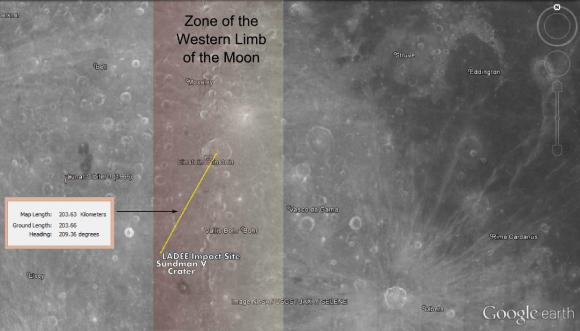
The LADEE impact site is within 300 meters of the location estimated by the LADEE team. The ground control team at Ames Research Center knew the location very well within just hours after the time of the planned impact. They had to know LADEE’s location in orbit with split-second accuracy and also know very accurately the altitude of the terrain LADEE was skimming over. LADEE was traveling at 1699 meters per second (3,800 mph, 5,574 feet/sec) upon impact.
But still, finding something as small as this crater can be difficult.
Looking at these images, the scale of lunar morphology is very deceiving. Craters that are 10 meters in diameter can be mistaken for 100 meter or even 1000 meters. The first image and third images (below) in this article are showing only a small portion of the external slope of the eastern rim of Sundman V, the satellite crater to the southeast of crater Sundman. Sundman V is 19,000 meters in diameter (19 km, 11.8 miles) whereas the first image is only 223 meters across.
The following image, which is the ratioing of “before” and “after” impact images by LROC, clearly reveals the impact scar from LADEE. LADEE’s crater is only approximately 10 feet in diameter (3 m) with the ejecta fanning out 200 meters to the west by northwest. LADEE was traveling westward across the face of the Moon that we see from Earth, reached the western limb and finally encountered Sundman.
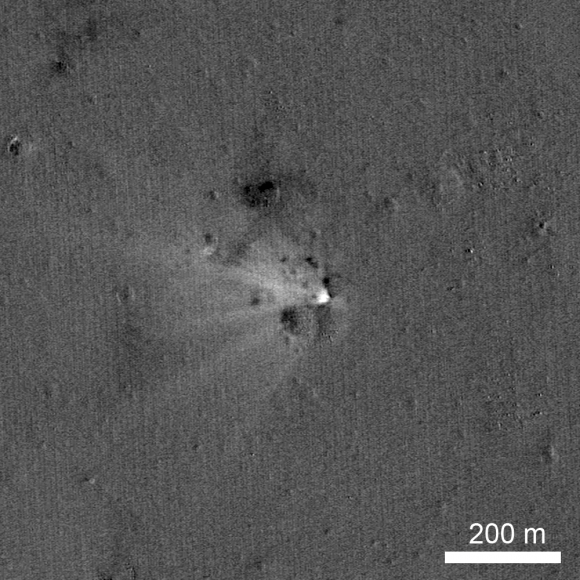
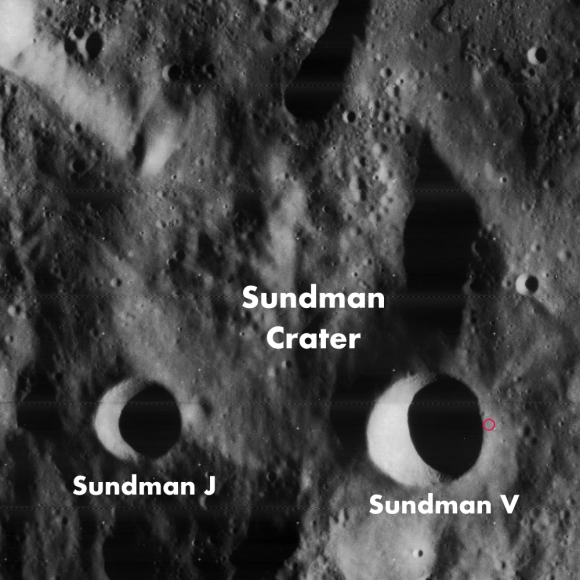
The discovery so close to the predicted impact site confirmed how accurately the LADEE team could model the chaotic orbits around the Moon – at least during short intervals of time. Gravitationally, the Moon is truly like Swiss cheese. The effects of upwelling magma during its creation, the effects of the Earth’s tidal forces, and all the billions of asteroid impacts created a very chaotic gravitational field. Where the lunar surface is higher or more dense, gravity is stronger and vice-versa. LADEE struggled to maintain an orbit that would not run into the Moon. Without a constant vigil by Ames engineers, LADEE’s orbit would be shifted and rotated relative to the Moon’s surface until it eventually would intersect the Lunar surface – run into the Moon. Eventually, this had to happen as LADEE ran out of propulsion fuel.
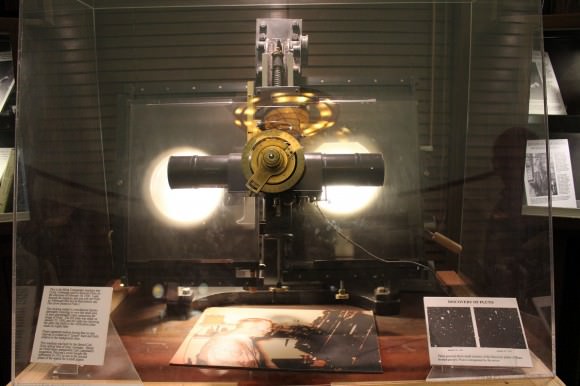
The method used by the LROC team in its basic approach is by no means new. Clyde Tombaugh used a blink comparator to search for Planet X for several months and many frame pairs of the night sky. The comparator would essentially show one image and then a second of the same view taken a few nights apart to Clyde’s eye. Tombaugh’s eye and brain could process the two images and identify slight shifts of an object from one frame to the other. Stars are essentially fixed, don’t move but objects in our solar system do move in the night sky over hours or days. In the same way, the new software employed by LROC engineers takes two images and compares them mathematically. A human is replaced by a computer and software to weed out the slightest changes between a pair of images; images of the same area but spaced in time. Finding changes on the surface of a body such as the Moon or Mars is made especially difficult because of the slightest changes in lighting and location of the observer (the spacecraft). The new LROC software marks a new step forward in sophistication and thus has returned LADEE back to us.
The following Lunar Orbiter image from the 1960s is high contrast and reveals surface relief in much more detail. Einstein crater is clearly seen, as is Sundman with J and V satellite craters on its rim.
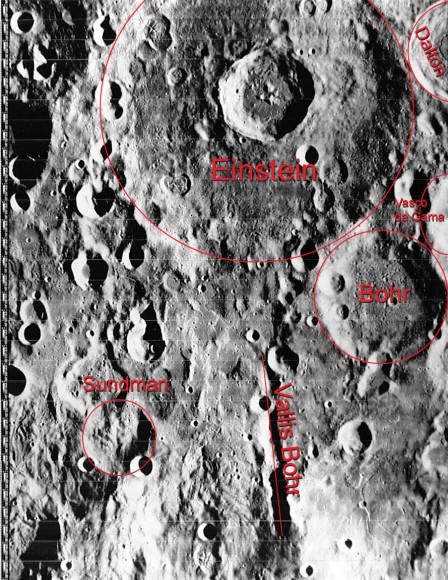
References:
NASA’s LRO Spacecraft Captures Images of LADEE’s Impact Crater
Karl Frithiof Sundman (28 October 1873, Kaskinen – 28 September 1949, Helsinki)

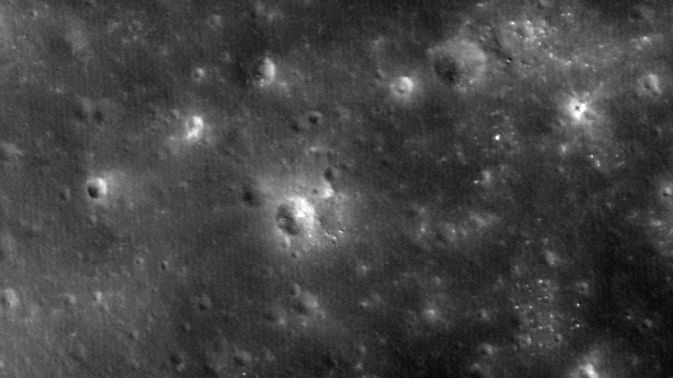
Great story Tim! Very thorough, complete. Love the the LADEE ray!